Surface Force, Topography and roughness Measurements
Contact persons:
Dr. Günter K. Auernhammer
Dr. Astrid Drechsler
Surface Forces
The interactions between solids on a nanoscopic scale determine many macroscopic properties as the stability of colloids or compounds, adhesion, wettability and bio-compatibility. They result from the interplay of different surface properties as charge, roughness and chemical composition and can be modified by thin adsorption layers.The interaction forces between a surface and a tip or colloidal particle on a microscopic scale can be measured directly. This measurement elucidates not only the interaction between surfaces and particles but gives also information about surface properties and the effect of adsorbed ions or molecules.
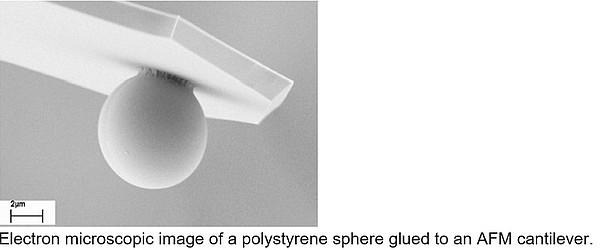
In our surface forces laboratory, we measure interaction forces in a distance range of nanometers up to some micrometers using a scanning force microscope (AFM) in the presence of air, vapor and solutions. With standard AFM tips, imaging of the surface topography and spatially resolved force measurements can be done at the same time (force-volume mode). For a quantitative evaluation of interaction forces, the colloid probe technique is applied: The AFM tip is replaced by a spherical colloidal particle of a few micrometers size. The colloidal probe technique allows not only the elimination of the probe geometry but also the application of a variety of materials (e.g. polymers) as force probes and the measurement of weak interactions.
Forces between chemically modified surfaces are investigated by chemical force microscopy. With the AFM, not only vertical but also lateral (friction) forces can be determined.
Current Topics
Two basic research projects supported by the DFG mainly on direct force measurements. In situ investigation of
• the interaction forces due to adhesion, polymer brushes, absorbed polymers, surface charges.
• the mechanical and electrostatic interaction of microplastic particle coated with an naturally grown eco-corona.
Topography and roughness Measurements
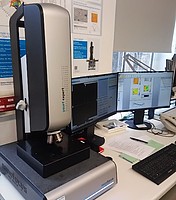
µsurf expert (NanoFocus AG)
scandisk confocal microscope
4 different objectives (10x - 100x)
measuring range: xy 160 - 1600 µm (larger areas by stitching), z range: 350 nm (piezo), 50 nm (motor)
max. resolution: xy 200 nm, z 3 nm
measuring time: seconds - minutes
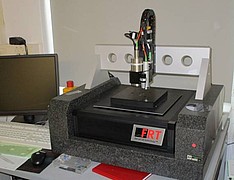
MicroGlider (Fries Research & Technology GmbH)
white light interferometer, scanning of the surface
measuring range: xy up to 100 mm, z 100 µm - 1mm (2 sensors)
resolution: xy 1 µm, z 10 nm
measuring time depends on number of pixels (1000x1000 ==> ca. 1 h)
additionally determination of layer thickness by interferometry
Mechanically scanning methods
Universal Surface Tester UST© (INNOWEP GmbH)
Profilometer: mechanical scanning of profiles (in 2D and 3D)
analysis of topography, structure, wear, abrasion, scratch resistance, micro friction, haptics
measuring range: xy 50 mm, z 250 µm
resolution: xy 1 - 100 µm, z 60 nm
Scanning Probe Microscopy (AFM, SPM)
various devices available (MultiMode, Dimension 3100, ICON - Bruker Corp.)
mechanical scanning with nanoscale tip
measuring range: xy 0.5 - 90 µm, z 10 µm
resolution: xy 10 nm, z 1 nm measuring time: 5 - 60 min (depends on area, roughness and image resolution)
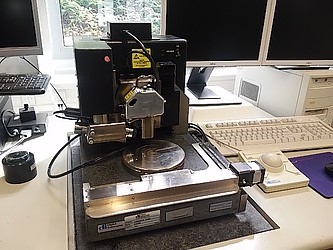
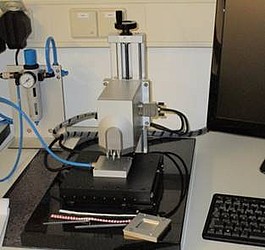
Literature
• B. Zhao, E. Bonaccurso, G. K. Auernhammer, L. Chen,
Elasticity-to-Capillarity Transition in Soft Substrate Deformation,
Nano Letters 21, 24, 10361–10367 (2021).
https://doi.org/10.1021/acs.nanolett.1c03643
• S. Arias, S. Amini, J. Horsch, M. Pretzler, A. Rompel, I. Melnyk, D. Sychev, A. Fery, H. G. Börner;
Toward Artificial Mussel-Glue Proteins: Differentiating Sequence Modules for Adhesion and Switchable Cohesion.
Angewandte Chemie International Edition 59, 18495-18499 (2020).
https://doi.org/10.1002/anie.202008515
• K. Schneider, I. Melnyk, K. Hiekel, A. Fery, G. K. Auernhammer, A. Eychmüller;
Mechanical Characterization of Self-Supported Noble Metal Gel Monoliths.
The Journal of Physical Chemistry C, 123, 27651—27658 (2019).
https://doi.org/10.1021/acs.jpcc.9b08607
• Elmahdy, Mahdy M. ; Drechsler, A. ; Bittrich, E. ; Uhlmann, P. ; Stamm, M.
Interactions between silica particles and poly(2-vinylpyridine) brushes in aqueous solutions of monovalent and multivalent salts
Colloid and Polymer Science 292 (2014) 1999-2012
• Drechsler, A. ; Synytska, A. ; Uhlmann, P. ; Stamm, M. ; Kremer, F.
Tuning the adhesion of silica microparticles to a poly(2-vinyl pyridine) brush: an AFM force measurement study
Langmuir 28 (2012) 15555-15565
• Drechsler, A. ; Synytska, A. ; Uhlmann, P. ; Elmahdy, Mahdy M. ; Stamm, M. ; Kremer, F.
Interaction forces between microsized silica particles and weak polyelectrolyte brushes at varying pH and salt concentration
Langmuir 26 (2010) 6400-6410

